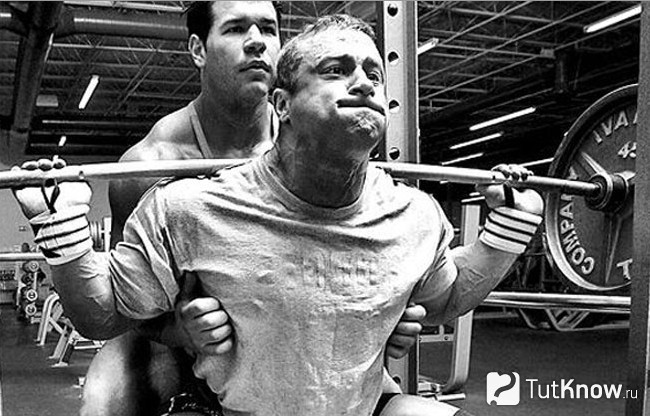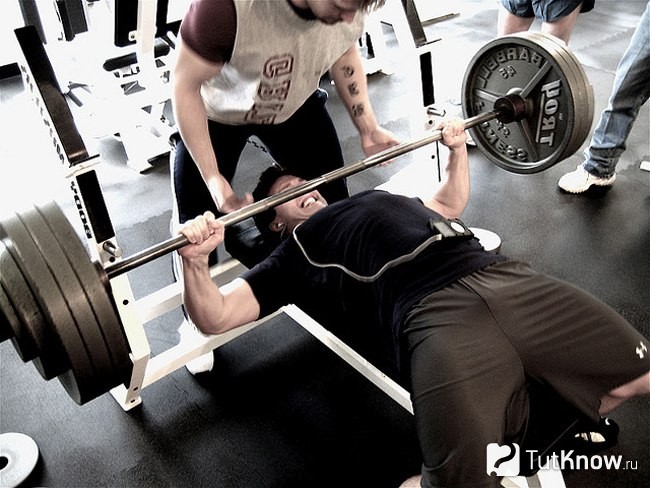How to increase weight in exercises. ★★★ FITNESS LIVE ★★★ Sports nutrition
Hello, in today's article I will answer the questions listed below. how to understand that it's time to lift heavier weights during strength training? By what signs to determine that you can already increase the weight of shells in the gym? What serves as a signal to increase the working weight of presses, traction, flexion and extension of joints in strength exercises. What principles of changing the weight of shells to adhere to and after what time of training can and should we increase weights for training with weights?
Here is the truth about training with weights: the only way to improve performance and results is to continue to increase the working weights of the shells with which you work when lifting the scales in the hall.
Your body is designed to adapt to the demands placed upon it. If you stop demanding more, it will not prevent adaptation - in our case, build up more muscle tissue. But how do you know when it's time to add more weight? The idea is to avoid stretching and overloading the muscles, which are some of the fastest ways to get injured.
So how can you be sure that increasing the workout load is already safe? Here are four main signs or signals:
A sufficient amount of time has passed to increase the working weight
The first sign that it's time to lift weights in weight training is when you have crossed the four to eight week training period with the same weight for this exercise. Your body will need several weeks to adapt to higher weights, but as a rule it adapts to the 6-week mark. As a rule, you can begin to add a little more weight by the time you reach the mark of four weeks of training with the same weight for the same exercise. Maybe you'll only add an additional 2 kg to the first approach, but do not worry, add at least a little. By the time you reach the mark of 6 to 8 weeks of training, you should be ready to add more weight in each approach.
To raise or reap the current weight is not so difficult
You should try to complete each approach, as well as the final approach of each exercise so that you leave your muscles exhausted and close to failure. Your body reacts only to the "haggard" muscles, meaning the muscles that work at the limit. The more you strain, the more muscles grow.
If the approach is not heavy enough - meaning, if you can complete it without much strain and difficulty - it's time to increase the working weight of this press, traction, or for flexing and unbending the joints in this power exercise. Do these approaches killer, to finally see the desired results in strength and muscle volume.
Your muscles do not get fatigued
Muscle fatigue is a sure sign that you are doing the right exercises using the right amount of weight. "Exhaustion" or fatigue is a sure sign that you have reached a state where you simply can not: your muscles can no longer tense up any more, or even make an approach, even with the help of an insurer. Your goal should be to achieve muscle fatigue or even muscle failure on the last approach of each exercise that you do.
If you do not reach such a mark of muscle fatigue, then you should definitely increase your weight. Work with a training partner (insurer), and make sure that he will spur you at the right time to achieve fatigue and muscle failure. Every repetition that you do afterachieving muscle fatigue as much as possible will bring you closer to the results of building muscle mass, which you have outlined for yourself.
You do not progress
If you are stuck, picking up the same weights with which you grind and thrust for a few weeks or months, it means that you stopped forcing yourself and your muscles to stop adapting. Even if you do not feel able to be managed in the hall as now only with heavier weight, it is still at least a little more, but add! You will find that your muscles adapt to the ups and downs with a higher load, and you will eventually be able to raise it with less difficulty than expected from yourself.
You do not have to pour another 10 to 15 kg on the bar. Just add between 2, 5 and 5 kg and see how great the difference in the effect of training is!
If at least one of these four signs refers to you, it's a signal that you need to start adding more weight to press and pull with more load, and as a result, and raise all your indicators in bodybuilding. Only by increasing working weights, once such signals are seen, you will get the results you want - to get more, stronger muscles!
And what signals do you consider as an indicator of how often to increase the working weight? Share with us and our readers in
Learn how to properly increase the working weight in a single training program. Familiarize yourself with the basic methods of progression and bring your muscle growth to a qualitatively new level!
Progress is a gradual and gradual increase in the working weight used in bodybuilding or strength training. The increase in working weight stimulates both muscle growth and the growth of strength indicators. But sometimes such a seemingly simple question can seem like a mystery behind seven seals.
Take a look at today's popular training programs, you can immediately notice one confusing circumstance: there are an infinite number of options for structuring approaches and repetitions. If you need to increase the working weight, you will have to compare these training schemes with a different number of sets and repetitions and ask the puzzling question:
How can you progress in a single scheme of approaches and repetitions?
I will try to answer this question. I'll take a popular training program with a certain number of approaches and repetitions and give you several options for solving the problem of how to increase the working weight.
Remember that there is no "better" way to progress. Use those approaches that you really like and make you look forward to the next workout. If you are moving forward - and no matter how fast and how, then you are moving in the direction of the coveted goal.
Efforts in training
Before I start, I want to focus on one important point. You must progress in every approach at every training session, and such devotion to the training process will certainly bear fruit. If you do not give the full program, the results will begin to decline. As soon as you start to stomp on the spot and stop pushing your body forward, you are as if telling the body that everything is in order, from this moment you can stop creating new muscles.
On forums, bodybuilders often have to meet such a statement: "I do not want to look like Arnold, but I just want to gain a little muscle mass." There is a high probability that in fact such a statement can be rephrased as follows: "In the gym I do not want to work until the seventh sweat, do not want to take a big working weight, do not want to change the diet significantly, but I still want to see the result."
It will be necessary to disappoint those who are looking for easy ways - in bodybuilding there are no easy ways. Even modest goals, for example, to gain "a little" muscle, maybe "just" 4-5 kg, require a constant increase in working weight (hard work) and a serious approach to compiling a diet based on the principles of true bodybuilding.
If you want a result - any result, no matter how small it seems to you - progression is crucial to achieving your goals.
Progress: fixed approaches
Here is an example of fixed approaches in training:
- 3 sets of 8 reps
- 4 sets of 10 repetitions
The essence of progress in the framework of fixed approaches is not to increase the number of repetitions in the approach, but to achieve the ultimate goal - a certain number of repetitions. This number of repetitions will be the same for all sets of exercises. For example, let's look at possible options for progress in the framework of fixed approaches to the 3x10 scheme.
The goal of progress is the First Approach. Use the same working weight for all three approaches. When you can complete 10 repetitions in the first approach, add weight. In the second and third approaches, the number of repetitions that you can complete will decrease as fatigue accumulates.
The goal of progress is All Approaches. Use the same working weight for all three approaches. Add weight when you can complete 10 repetitions in all approaches. In the first approaches, you can do more than ten repetitions, and you can always adhere to a given amount.
Progress: the set range of repetitions
Within the limits of many training programs a certain range of repetitions is set, within which you must work. As a rule, it looks like this:
- 3 sets of 6-10 reps
- 4 sets of 10-15 repetitions
Progression within the specified range of repetitions occurs in the same way as for a fixed number of repetitions. Take the 3x6-10 scheme as an example - you can increase the working weight when doing 10 repetitions in the first approach, or you can add weight when complete 10 repetitions in all three approaches.
Many visitors to the gym think that they need to use a different number of repetitions and different working weight for approaches based on the set range of repetitions. This is not true. Of course, if you want, you can increase the working weight from the approach to the approach, but in this case you will have to constantly throw in discs and record or memorize the results of each set on each workout, and very soon you will get tired of it.
Do not forget that you go to the gym to lift weights, and training with one working weight saves time and helps you concentrate on your immediate goals. For a given range of repetitions, I strongly recommend using the same weight for all approaches and building a strategy for progress on this solid foundation.
Progress: approaches to the descending pyramid
Approaches to the pyramid are a very popular principle. As a rule, in training programs, descending pyramids are used, that is, the number of repetitions decreases with each approach. Here is a popular example of a descending pyramid:
- 4 approaches - 12, 10, 8 and 6 repetitions
There are 2 main ways to progress within the descending pyramid:
Progress with a constant working weight. In the example above (4 sets of 12, 10, 8 and 6 repetitions), the athlete uses the same weight in all four approaches. When you can complete 12 repetitions in the first approach, you must increase the weight. As accumulation of fatigue is already impossible to perform a large number of repetitions in the approach, so the descending pyramid has become such a popular training scheme. And not gonies for the exact number of repetitions. It is much more important to carry out each approach qualitatively, and not to worry about necessarily completing 12, 10, 8 and 6 repetitions.
Progress with increasing working weight. Many athletes prefer to increase the working weight from the approach to the approach. For example, in the classical scheme of growth of working weights is as follows:
- 90 kilograms x 12 reps
- 100 x 10 repetitions
- 110 x 8 reps
- 115 x 6 reps
This is a great way to build a descending pyramid, but it can make confusion when you decide how you progress. Personally, I recommend starting, first of all, from the number of repetitions with the heaviest weight: when you can complete all 6 repetitions in the last approach, add weight in all sets.
Of course, you can add weight in a single approach as you reach the specified number of repetitions. The problem is that, most likely, with this approach, you will eventually use the same working weight (or very close weights) in all four sets.
As already mentioned, because of the accumulation of fatigue, you are unlikely to complete the same number of repetitions in successive approaches. So, if in the first approach you can squeeze 110 kg 12 times and at the same time lay out one hundred percent, then most likely in the second approach with 110 kg you can only do 8-10 repetitions, and in the third, probably not more than 5-8 with the same 110 kilograms.
Concluding remarks
Very often the beginning athlete thoroughly studies the training program and becomes obsessed with the number of repetitions. He mistakenly believes that the secret of success lies in the achievement of a certain number of repetitions, which is indicated by the author of the methodology. This is not true.
The secret of success lies not in any specific number of repetitions. In most training programs, the number of repetitions is advisory in nature and is only a certain guideline. Do not focus on doing the exact number of repetitions, do not try to reduce the working weight from approaching the approach, just to complete the required number of repetitions. Take as a basis the principle of consistent and gradual progression and give this aspect of maximum attention.
In force training there are no magic recipes. You have to be consistent, do not skip training and eat according to the principles of bodybuilding. And focus on progression in the gym.
Looking for the best ways to maximize the result of training? Do you want to get weaker and stronger? There are many ways to increase your strength and muscle mass, from using sports supplements to changing your training program. Depending on your level of physical training, you can try various tricks, for example, make supersets or sets of pyramids, or experiment with more advanced technique of lifting weights.
It is important to know that your diet and your training program are of great importance in achieving your goal. Exercises can not compensate for poor nutrition. If your diet is under control and you already have a good exercise program, read our 5 rules, how to raise more weight and quickly grow stronger.
1. Try another range of repetitions
Training in the same range of repetitions will ultimately lead to a plateau (stagnation in the growth of muscles). Although it is true that the average range of repetitions stimulates muscle growth, this does not mean that you must constantly follow this rule. To get more, train in a lower range of repetitions with heavier weights. Perform one to five repetitions in each approach, using the maximum load. Thus, you will create tension in the muscles and stimulate growth. There is a lot of controversy about the ideal range of repetitions, so you should try different methods to see what works best for you.
2.Work on weak points
Many bodybuilders have a huge back and huge arms, but their lower body lags behind. Others have huge legs and small shoulders. You probably also have weaknesses. To raise more weight and become stronger, you need to focus on these areas. Keep in mind that what works for one person may not work for another. It is important to plan your training taking into account your body type, strength and experience. Train the lagging muscle groups twice a week, use a lot of weight and eat more calories on those days when you lift heavy weights.
3. Eat more carbohydrates
One of the easiest ways to maximize your benefits is to eat more carbohydrates. These nutrients are stored in the form of glycogen in the muscles and liver. Each gram of carbohydrates can hold up to four grams of water, making your muscles full. So, if you want to look inflated on any day, eat four or five grams of carbohydrates per kilogram of weight. Choose slow carbohydrates, such as those found in rice, whole grains, oatmeal and sweet potatoes. Do more workout training to burn excess calories. This strategy will give you more strength and works best if you reduce carbohydrate intake three days before a large load.
4. Focus on progressive overload
Progressive overload is an important concept in bodybuilding. This is the principle that all other principles must be retreated. The only way to become bigger and stronger is to gradually increase the load on the muscles during training. This means that you must gradually increase the load, do more repetitions and work with more intensity.
There are various ways to include progressive overload in your workout program. You can lift the same weight more times, increase the frequency of training, do the same job losing body weight, or use heavier weights. Keep in mind that progressive overloads for beginners differ from overloads of professional bodybuilders, so you need a training program with your abilities in mind.
5. Perform challenging exercises
When it comes to muscle growth, complex exercises are your best choice. Squats, traction, bench press, pull-ups, standing barbells and other multipurpose movements activate muscle fibers and increase your overall strength. These exercises strengthen your muscles, forcing them to grow. They also involve several muscle groups, strengthen your press and burn more calories.
Combined exercises not only make you stronger, but also support the heart rate, improve the balance of muscles and increase the stability of the joints. In addition to isolating exercises, standard training should include at least two compound movements.
For example, you can do push-ups and pull-ups while training your chest, arms, or shoulders. Squats and traction are mandatory for your feet. If you want massive hands, focus on the crests and pressing movements, and not on the bicep's insulation. For bigger legs, squat with heavy weights, and do not do five bench presses in the machine. Isolating exercises are also very important, but complex exercises are the key to answering the question how to raise more weight and the building of muscle mass.
Find out when and how to lift the working weight. Also, you will become aware of the methods of deducing the growth of muscle mass to a new level.
The content of the article:
Everyone knows that increasing the working weight contributes to muscle growth. But very often it is interesting for athletes to know how and when to increase the working weight in bodybuilding. If you look at most of the known training programs, they have a large number of options for approaches and repetitions. To increase the working weights in this case, we will have to compare these schemes with different number of sets and approaches in them. As a result, it is not clear to everyone how one can make progress in one training program. Today we will answer this question.
Load on the workout will increase the working weight

Immediately need to say that you need to make progress in every lesson. If you reduce the requirements for your training, the results will quickly fall. At this moment, when muscle growth has stopped, the body can decide that it is enough to increase muscle volumes.
Fans often say that they do not have the goal of being like the stars of the world's bodybuilding, but such a statement can be interpreted as a simple reluctance to fully put in the hall. Such athletes want to say that even the most insignificant goal requires a lot of work.
Fixed approaches to increase working weight

As an example, you can take the following program:
- 3 sets of 6 repetitions;
- 4 sets of 12 replicates.
To make progress, you can use one weight for each of the three approaches. After you begin to perform 10 repetitions in the first approach, you can increase the working weight. In the following two approaches, the number of repetitions will decrease depending on the degree of your fatigue.
You can use the second method. You also use the same weight in all approaches. Increase weight when you perform all 10 repetitions in each approach. You can also do more repetitions in the first approaches.
Specified range of repetitions and increase in working weight

Very often the training program sets a certain range of repetitions, in which the athlete must work. It can look like this:
- Three approaches from 6 to 10 repetitions;
- Four approaches from 10 to 15 repetitions.
Often, athletes consider that it is necessary to use a different number of repetitions and different weights for each approach. This judgment is not entirely correct. Of course, you can increase weight with each new approach, but it's quite tiring. In this case, you will have to keep a record of the results of each set. It is best to use the same weights in a given repetition interval.
Increase in working weight by approaches on a descending pyramid

The use of pyramid approaches is very popular among athletes. One such scheme is the following: you perform four approaches for 12, 10, 8 and 6 repetitions. It should be noted that there are two ways to progress within a single pyramid.
Probably, you are already beginning to understand how and when to increase the working weight in bodybuilding.
Constant weight

Again consider the previous example, when the athlete uses the same weight in all approaches. After the last approach was completed in the first approach, you can increase the weight. In each subsequent set, the number of approaches will decrease due to fatigue. This is one of the main reasons for the high popularity of this method. Also it should be said that there is no need to strive for the exact implementation of the entire number of repetitions. For progress, it is more important to perform each of the sets qualitatively, and not to worry about the exact number of repetitions.
Increasing weight

Often, athletes prefer to increase weight before each new approach, and with each increase the number of repetitions will drop. Of course, this is an excellent type of pyramid, which is also very effective. However, it is better to increase the weight after the last set you can perform all the necessary repetitions.
You, if desired, can use the original technique, i.e. increase weight after each approach. But very often the result is that in all approaches the athlete will use very close weights or even the same.
Since fatigue will gradually accumulate, then most likely you will not be able to perform an equal number of repetitions in the final sets. If, for example, you could squeeze 100 kilograms 10 times in the initial set, laying out to the full, then in the second set with the same weight, you will most likely manage to do 8 repetitions, and in the third even less.
Conclusion
![]()
Beginners often carefully study the popular training program and, as a result, get hung up on the number of repetitions. They are inexperienced, assuming that their future progress depends on this. This is a misconception.
The secret of progress lies not in the mystical number of repetitions. Most often these figures are strictly recommendatory, but not mandatory. This is a simple reference point, which should be equal, but follow it implicitly. Do not focus on repetition, and also reduce the working weight after each of the sets just to ensure that all repetitions have been performed. You need to gradually progress and this is what you should focus on.
It is important to remember that in any sport there are no secret techniques and strategies that guarantee 100% success. You just need to gradually get closer to your goal, not skipping workouts and paying great attention to your nutrition program.
That's all that can be said about how and when to increase the working weight in bodybuilding.
Find out more information about the increase in working weight in this video:
In bodybuilding there is such a thing as progress - this is a gradual and periodic increase in the working weight. Progress is needed in order to stimulate the growth of muscles and strength indicators. It would seem, to understand when this progress is needed - it is easier than easy, but in reality everything is not so simple, especially for a beginner athlete. Let's understand. Pay attention, all modern training programs are built on approaches and repetitions. If you want to develop, then you need to increase their number on EVERY workout. The first time will be difficult, but believe me, your efforts will quickly bear fruit. The main thing is perseverance and the desire to be better. If you do not give your best in training, then the result will have to wait a very long time. Once you start to be lazy - it's a signal for the body that it's enough to work on the muscles. Very often people say that they are afraid of pumping. In fact, this means only one thing, that a person is not ready to work in the gym, but wants to see the result. In sports, you must always perebaryvat yourself, only then will the results appear. Even a seemingly modest desire to lose a few pounds, in fact, will turn into hard labor in the hall until the seventh sweat.
How often do I need to change the number of approaches and repetitions?
 Constantly. Today you have done three approaches ten times. Tomorrow there should already be four approaches 12 times. And to increase approaches and repetitions it is necessary in one exercise, and in all which you carry out. That is, for example, you do squats, push-ups and pull-ups. At each workout, you must make an equal number of approaches and repetitions in each exercise. From training to training, the number of repetitions and approaches should only grow.
Constantly. Today you have done three approaches ten times. Tomorrow there should already be four approaches 12 times. And to increase approaches and repetitions it is necessary in one exercise, and in all which you carry out. That is, for example, you do squats, push-ups and pull-ups. At each workout, you must make an equal number of approaches and repetitions in each exercise. From training to training, the number of repetitions and approaches should only grow.












